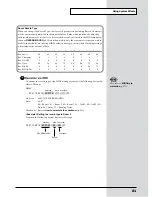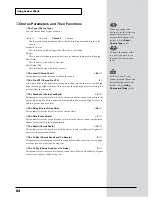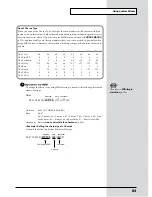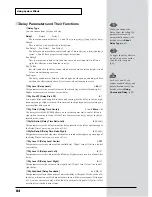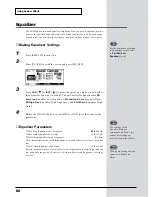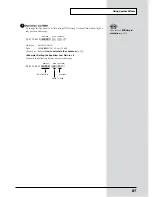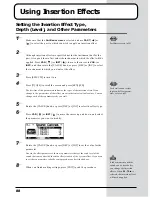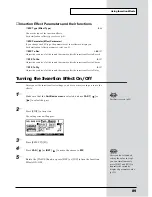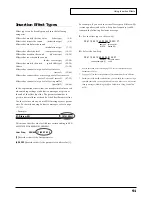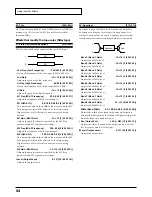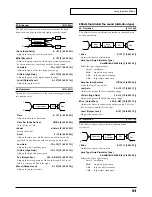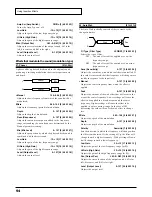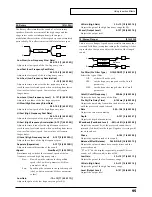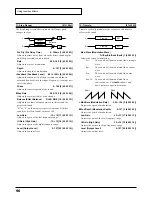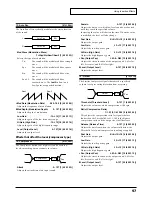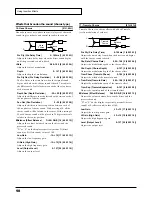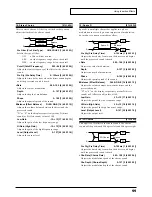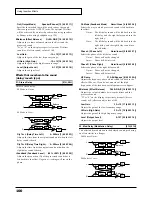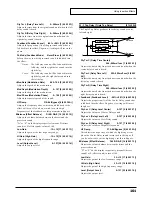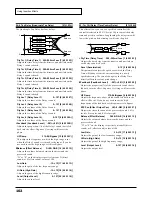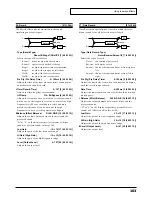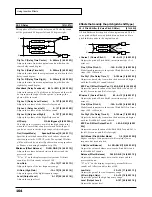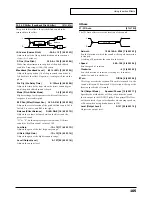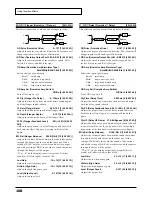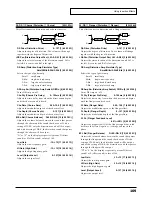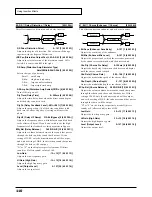
95
Using Insertion Effects
09: Rotary
[01H, 22H]
The Rotary effect simulates the sound of a classic rotary
speakers. Since the movement of the high range and low
range rotors can be set independently, the unique
modulation characteristics of these speakers can be simulated
quite reliably. This effect is most suitable for electric organ.
fig.9-9
Low Slow (Low Frequency Slow Rate)
0.05–10.0 [1 (40 03 03)]
Adjusts the slow speed of the low frequency rotor.
Low Fast (Low Frequency Fast Rate)
0.05–10.0 [2 (40 03 04)]
Adjusts the fast speed of the low frequency rotor.
Low Accl (Low Frequency Acceleration)
0–15 [3 (40 03 05)]
Adjusts the time it takes for the low frequency rotor to
reach the newly selected speed when switching from fast to
slow (or slow to fast) speed. Lower values will require
longer times.
Low Level (Low Frequency Level)
0–127 [4 (40 03 06)]
Adjusts the volume of the low frequency rotor.
Hi Slow (High Frequency Slow Rate)
0.05–10.0 [5 (40 03 07)]
Adjusts the slow speed of the high frequency rotor.
Hi Fast (High Frequency Fast Rate)
0.05–10.0 [6 (40 03 08)]
Adjusts the fast speed of the high frequency rotor.
Hi Accl (High Frequency Acceleration) 0–15 [7 (40 03 09)]
Adjusts the time it takes for the high frequency rotor to
reach the newly selected speed when switching from fast to
slow (or slow to fast) speed. Lower values will require
longer times.
Hi Level (High Frequency Level)
0–127 [8 (40 03 0A)]
Adjusts the volume of the high frequency rotor.
Separate (Separation)
0–127 [9 (40 03 0B)]
Adjusts the spatial dispersion of the sound.
+Speed
Slow/Fast [11 (40 03 0D)]
Simultaneously switches the rotational speed of the low
frequency rotor and high frequency rotor.
Slow:
Slows down the rotation to the specified
speed (the Low Slow parameter/Hi Slow
parameter values).
Fast:
Speeds up the rotation to the specified speed
(the Low Fast parameter/Hi Fast parameter
values).
Low Gain
-12–+12 [17 (40 03 13)]
Adjusts the gain of the low frequency range for EQ.
Hi Gain (High Gain)
-12–+12 [18 (40 03 14)]
Adjusts the gain of the high frequency range for EQ.
#Level (Output Level)
0–127 [20 (40 03 16)]
Adjusts the output level.
10: Stereo Flanger
[01H, 23H]
This is a stereo flanger. It produces a metallic resonance that
rises and falls like a jet airplane taking off or landing. A filter
is provided so that you can adjust the timbre of the flanged
sound.
fig.9-10
Pre Filter (Pre Filter Type)
Off/LPF/HPF [1 (40 03 03)]
Selects the type of filter.
Off:
a filter will not be used
LPF:
cut the frequency range above the Cutoff
parameter
HPF:
cut the frequency range below the Cutoff
parameter
Cutoff (Cutoff Frequency)
250–8k [2 (40 03 04)]
Adjusts the basic frequency of the filter.
Pre Dly (Pre Delay Time)
0–100ms [3 (40 03 05)]
Adjusts the time delay from when the direct sound begins
until the processed sound is heard.
+Rate
0.05–10.0 [4 (40 03 06)]
Adjusts the rate of modulation.
Depth
0–127 [5 (40 03 07)]
Adjusts the depth of modulation.
#Feedback (Feedback Level)
-98%–+98% [6 (40 03 08)]
Adjusts the amount (%) of the processed sound that is
returned (fed back) into the input. Negative (-) settings will
invert the phase.
Phase
0–180 [7 (40 03 09)]
Adjusts the spatial spread of the sound.
Balance (Effect Balance)
D>0E–D0<E [16 (40 03 12)]
Adjusts the volume balance between the direct and the
processed sound.
“D” or “E” on the display respectively means D (direct
sound) or E (effect sound) values of 100.
Low Gain
-12–+12 [17 (40 03 13)]
Adjusts the gain of the low frequency range.
Hi Gain (High Gain)
-12–+12 [18 (40 03 14)]
Adjusts the gain of the high frequency range.
Level (Output Level)
0–127 [20 (40 03 16)]
Adjusts the output level.
L
R
EQ
EQ
Rotary
L
R
Flanger
Flanger
Balance
EQ
EQ
Содержание Sound Canvas SC-8850
Страница 256: ...SC 8850 Owner s Manual 01891545 00 7 A3 31N...

